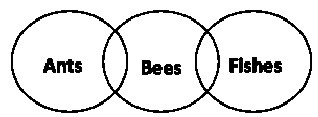Question
Two statements are given followed by two conclusions
numbered I & II. Assuming the statements to be true, even if they seem to be at variance with commonly known facts, decide which of the conclusions logically follow(s) from the statements. Statements: Some ants are bees Some bees are fishes Conclusions: I. Some ants are fishes Il. Some fishes are beesSolution
The least possible Venn diagram is given below based on the given statements. Conclusion: Some ants are fishes → Does not follow → (There is no definite relation between ants and fishes so it might be possible but not definitely true) Some fishes are bees → Follows → (Because some bees are fishes, so some fishes are bees is definitely true)  So, only conclusion II follows. Hence, the correct answer is (B).
So, only conclusion II follows. Hence, the correct answer is (B).
If "I & J # S % O * D & L @ N" is definitely true, then how is O related to J?
'A # B' means 'A is the husband of B'. 'A @ B' means 'A is the mother of B'. 'A & B' means 'A is the sister of B'. 'A $ B' means 'A is the child of B'. ...
If 'A @ B' means 'A is the daughter of B'. 'A & B' means 'A is the husband of B'. 'A % B' means 'A is the wife of B'. 'A $ B' means 'A is mother of B'....
If ‘L#H$I@G?W*K’ is true, then, how is K related to L?
If 'A@B' means 'A is father of B', 'A#B' means 'A is wife of B', 'A$B' means 'A is sister of B', 'A%B' means 'A is brother of B'. If 'R @ S $ T # V @ U ...
'A@B' means 'A is the father of B'. 'A#B' means 'A is the sister of B'. 'A$B' means 'A is the brother of B'. 'A%B' means 'A is the wife of B'. If F $ G...
‘A@B’ means ‘A is the father of B’. ‘A#B’ means ‘A is the sister of B’. ‘A$B’ means ‘A is the brother of B’. ‘A%B’ means �...
Answer the questions based on the information given below.
In a certain language,
A & B means A is married to B
A # B means...
In a certain code language,
X + Y means 'X is the father of Y'
X - Y means 'X is the brother of Y',
X X Y means 'X is the sister of...
If P is the father of I, then which of the following symbol will correct it in the given blank?
Q % P __ O # I
Relevant for Exams:


